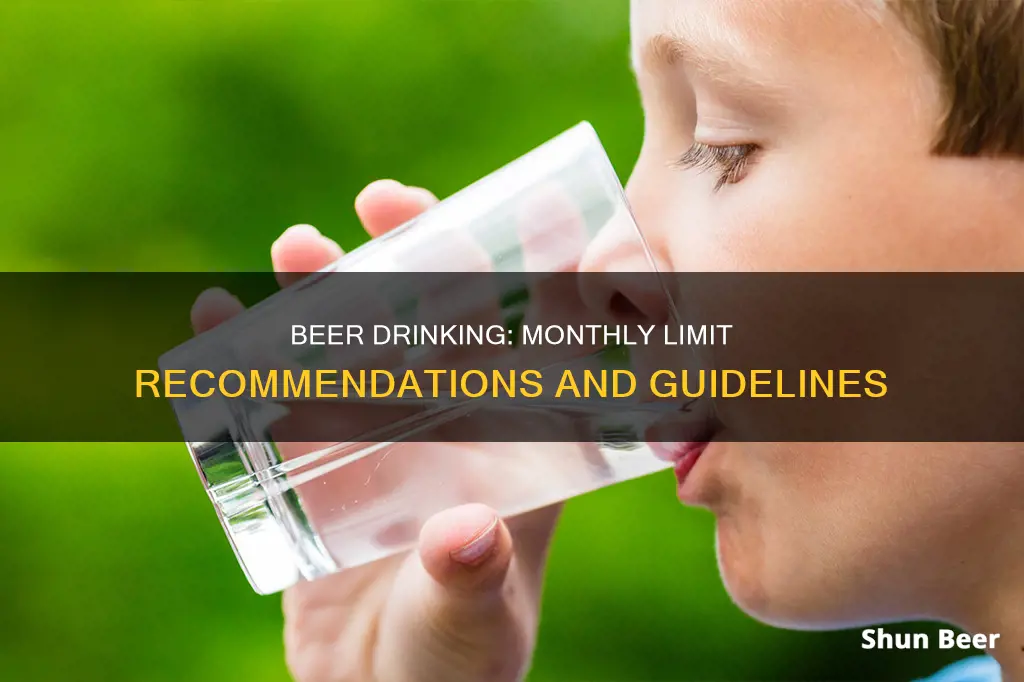
Drinking beer in moderation can offer some health benefits, such as lowering the risk of diabetes, reducing the risk of heart disease, and increasing bone density in men. However, excessive drinking can lead to several health issues and increase the risk of chronic diseases. So, how much beer is too much? This article will explore the recommended limits for beer consumption and the potential consequences of exceeding these limits. It will also discuss strategies to cut back on drinking and the benefits of seeking professional help.
| Characteristics | Values |
|---|---|
| Number of beers that constitute binge drinking for men | 5 or more in 2 hours |
| Number of beers that constitute binge drinking for women | 4 or more in 2 hours |
| Number of beers that constitute heavy drinking for men per week | 15 or more |
| Number of beers that constitute heavy drinking for women per week | 8 or more |
| Number of beers that constitute moderate drinking for men per day | 2 or fewer |
| Number of beers that constitute moderate drinking for women per day | 1 or fewer |
What You'll Learn

Risks of drinking beer
Beer is a drink made by fermenting sugars from starches. Barley, hops, water, and yeast are its major components. It can be alcoholic or non-alcoholic. Typical American alcoholic beers average 4% to 5% alcohol (ethanol) by volume, but some can be much higher.
While drinking beer in moderation may offer some health benefits, excessive beer consumption can have serious adverse effects on your health, safety, and overall well-being. Here are the risks of drinking beer:
Health Risks
- Weight Gain and Obesity: Beer contains empty calories, meaning it provides energy without essential nutrients. Excessive beer consumption can lead to weight gain and obesity, which are risk factors for various health issues.
- Heart Disease: While moderate alcohol consumption may reduce the risk of heart disease, excessive drinking can have the opposite effect. It can increase your risk of cardiovascular problems, including coronary heart disease, hypertension, and an irregular heartbeat.
- Liver Disease: Long-term excessive drinking can cause serious liver problems, including liver disease and an increased risk of certain types of cancer.
- High Blood Pressure: Drinking more than two 12-ounce beers per day for men and one 12-ounce beer per day for women can lead to high blood pressure and make existing high blood pressure worse.
- Stroke: Excessive drinking increases the risk of both ischemic and hemorrhagic strokes.
- Weakened Immune System: Consuming three or more drinks per day is associated with a weakened immune system, making you more susceptible to infections and illnesses.
- Digestive Issues: Alcohol can irritate the digestive tract and worsen conditions such as gastroesophageal reflux disease (GERD) and stomach ulcers. It can also increase the risk of pancreatitis.
- Diabetes: While light to moderate drinking may lower the risk of type 2 diabetes, excessive drinking can increase this risk.
- Nutritional Deficiencies: Heavy drinking can lead to malnourishment and vitamin deficiencies.
- Mental Health Issues: Excessive drinking is associated with an increased risk of depression and anxiety. It can also lead to trouble controlling emotions and problems with memory and learning.
- Alcohol Dependency: Consuming large amounts of alcoholic beer long-term can lead to alcohol dependence and alcohol use disorders.
Safety Risks
- Injuries and Accidents: Excessive drinking increases the risk of unintentional injuries, including car crashes, falls, burns, and drownings.
- Violence and Assault: Alcohol can increase the likelihood of violent activities, including homicide, suicide, domestic violence, and sexual assault.
- Risky Sexual Behaviors: Drinking excessively can lead to unprotected sex or sex with multiple partners, increasing the risk of unintended pregnancies and sexually transmitted infections (STIs).
- Pregnancy-Related Issues: Alcohol consumption during pregnancy can cause birth defects, miscarriage, fetal alcohol syndrome, and developmental and behavioral disorders in the child.
Social and Professional Risks
- Job-Related Problems: Excessive drinking can lead to decreased productivity, job loss, and issues with colleagues and clients.
- Relationship Problems: Heavy drinking can cause conflicts and strain relationships with friends, family, and romantic partners.
It is important to note that these risks are not limited to beer specifically but apply to excessive consumption of any alcoholic beverage. The key to minimizing these risks is moderation. For adults who choose to drink, it is generally recommended to limit intake to one drink or less per day for women and two drinks or less per day for men. However, it is important to prioritize health and safety and avoid drinking altogether if necessary.
Energy and Alcohol: Do Beer and Red Bull Work?
You may want to see also

Recommended limits for men
According to the Dietary Guidelines for Americans, the recommended limit for men is no more than two "standard" drinks per day. This amounts to 28 grams of pure alcohol per day.
A standard drink is defined as 14 grams of pure alcohol, which is typically found in 12 ounces of regular beer, 5 ounces of wine, or 1.5 ounces of spirit.
It is important to note that this limit is per day and is not intended as an average over several days. Binge drinking, which is defined as consuming five or more drinks within two hours for men, is considered excessive and can lead to serious health consequences.
Heavy drinking is defined as consuming 15 or more drinks per week for men. This level of consumption is considered high and can increase the risk of alcohol-related problems, including alcohol use disorder.
Excessive alcohol consumption can have detrimental effects on both physical and mental health. It can damage vital organs, affect mood and behaviour, and increase the risk of chronic diseases such as liver disease, heart disease, and cancer.
Therefore, it is recommended that men limit their alcohol consumption to no more than two standard drinks per day and no more than 14 drinks per week. This will help reduce the risk of negative health consequences and ensure a healthier lifestyle.
Beer and Gas: Is There a Link?
You may want to see also

Recommended limits for women
The recommended limits for women are lower than those for men. According to the National Institute on Alcohol Abuse and Alcoholism (NIAAA), women should limit their intake to one drink or less per day, not averaged over several days. This is because women's bodies tend to have less water content than men's, so after a woman and a man of the same weight drink the same amount of alcohol, the woman's blood alcohol concentration (BAC) will be higher, increasing her risk of harm.
In the United States, a "standard" drink contains about 14 grams of pure alcohol. This is generally the amount in 12 ounces of regular beer (5% alcohol), 5 ounces of wine (12% alcohol), or 1.5 ounces of distilled spirits (40% alcohol). It's important to note that different types and brands of alcoholic beverages can contain varying amounts of alcohol. For example, some microbrews have more than 5% alcohol, so if you drink a beer that's 10% alcohol, you're consuming two "standard" drinks worth of alcohol.
Exceeding the recommended limits can have negative health consequences. Heavy drinking is defined as consuming more than three drinks in one day or more than seven drinks per week for women. Binge drinking, on the other hand, refers to consuming enough alcohol to raise your BAC to 0.08% or higher in a short period of time. For women, this typically occurs after consuming four or more drinks within two hours.
It's important to note that even moderate drinking can be linked to certain health risks, such as breast cancer and an increased risk of stroke. Therefore, it's recommended to limit alcohol intake as much as possible to reduce these risks.
Beer and BAC: The Faster You Drink, The Higher It Gets
You may want to see also

Binge drinking
To reduce the risks associated with binge drinking, it is recommended to follow low-risk drinking guidelines. These guidelines suggest that it is safest for both men and women to drink no more than 14 units of alcohol per week, spread over three or more days with several drink-free days and no bingeing. To stay within safe limits, individuals can track their drinking, set drinking goals, and avoid triggers that may cause them to drink excessively.
The risks of binge drinking are significant and include both immediate and long-term dangers. In the short term, individuals who binge drink are at risk of accidents, falls, alcohol poisoning, and other health issues. Over time, repeated binge drinking can lead to damage to the stomach, pancreas, liver, and brain, as well as an increased risk of developing an addiction to alcohol.
Beer and Heartburn: What's the Connection?
You may want to see also

Risky drinking
Excessive alcohol consumption is a component cause of more than 200 diseases and injury conditions, including alcohol use disorder, liver cirrhosis, cancer, and physical injury. According to the World Health Organization, more than 3 million deaths, or 5.3% of all deaths worldwide, can be attributed to alcohol.
Binge Drinking
Binge drinking is defined by the Centers for Disease Control and Prevention (CDC) as "a pattern of drinking that brings a person's blood alcohol concentration (BAC) to 0.08 g/dl or above." For men, this typically happens after consuming five or more drinks within two hours. For women, binge drinking means consuming four or more drinks within two hours. Twelve ounces of regular beer equals one standard drink.
Heavy Drinking
Heavy drinking is defined as eight drinks or more per week for women and at least 15 drinks per week for men. This doesn't necessarily mean that a person is binge drinking, as this might be spread out over an entire week. However, above these standard levels, a person's overall consumption begins to be considered "high."
Alcohol Misuse
Alcohol misuse refers to drinking in a manner, situation, amount, or frequency that could cause harm to the drinker or those around them. Alcohol misuse includes binge drinking and heavy alcohol use.
Alcohol Use Disorder (AUD)
AUD is a medical condition characterized by an impaired ability to stop or control alcohol use despite adverse social, occupational, or health consequences. It includes the conditions that some people refer to as alcohol abuse, alcohol dependence, alcohol addiction, or alcoholism. AUD can be mild, moderate, or severe. Lasting changes in the brain caused by alcohol misuse perpetuate AUD and make individuals vulnerable to relapse.
There is no safe drinking level. However, the U.S. government defines and recommends levels of alcohol consumption that generally carry only low to moderate risk for the general population. According to the U.S. Department of Health and Human Services Dietary Guidelines, the daily limit for women and men is one and two drinks, respectively. These amounts are not intended as an average but rather as a daily limit. It is important to note that women should be aware that even moderate drinking may increase the risk of breast cancer.
Jaw Surgery and Beer: What's Safe to Drink?
You may want to see also
Frequently asked questions
There is no recommended amount of beer to drink in a month. However, doctors consider drinking more than 14 beers a week for men and more than seven beers a week for women to be "heavy" or "at-risk" drinking.
Excessive drinking is divided into two categories: binge drinking and heavy drinking. Binge drinking is defined as consuming enough alcohol to raise your blood alcohol concentration (BAC) to 0.08% or higher. This typically means drinking five or more beers in two hours for men and four or more beers in two hours for women. Heavy drinking is defined as drinking 15 or more beers a week for men and eight or more beers a week for women.
Excessive drinking can increase your risk of many serious health issues, including unintentional injuries, violence, risky sexual behaviours, memory and learning problems, early and permanent dementia, inflammation and damage to organs, chronic diseases such as liver disease, heart disease, stroke, high blood pressure, and cancer, ulcers, malnourishment, weakened immune system, higher risk of obesity, and mental health issues such as depression and anxiety.
In moderation, drinking beer may offer some health benefits, including a lower risk of diabetes, heart disease, and Alzheimer's or dementia. However, heavy drinking can reverse these benefits and increase the risk of developing these conditions.







